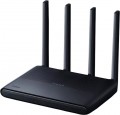Operating ranges
The number of wireless bands and channels supported by the router. Specified only for models that work with more than one range.
—
Dual-band (2.4 GHz and 5 GHz). Devices that simultaneously support two popular communication bands — 2.4 GHz and 5 GHz — in the "one communication channel per band" format. This ensures compatibility with most Wi-Fi standards (see above), and in some cases also has a positive effect on the quality of communication. For example, a Wi-Fi adapter (see "Device Type") with this feature may provide the ability to evaluate the load on both bands and automatically select the less loaded one.
—
Three-channel (2.4 GHz and 5 GHz in 2 channels). An improved version of the dual-band operation format: in the 5 GHz band, communication is carried out on two channels. This allows, for example, to “raise” three wireless connection channels on one router at once (three visible networks in the list of wireless networks) and achieve even higher throughput. The advantages of this format are especially noticeable when the router works simultaneously with several wireless devices.
—
Tri-band (2.4 GHz, 5 GHz, 60 GHz). The most "omnivorous" type of modern Wi-Fi equipment, compatible with all popular standards — from the outdated 802.11 b / g to the relatively new 802.11 ad. Also, the abundance of ranges contributes to an increase in spee
...d, especially when working with multi-range devices.Wireless speed 2.4 GHz
The maximum speed provided by the device when communicating wirelessly in the 2.4 GHz band.
This range is used in most modern Wi-Fi standards (see above) - as one of the available or even the only one. The theoretical maximum for it is 600 Mbit. In reality, Wi-Fi at a frequency of 2.4 GHz is used by a large number of client devices, from which congestion of data transmission channels emerges. Also, the number of antennas affects the speed performance of the equipment. It is possible to achieve the speed declared in the specification only in an ideal situation. In practice, it can be noticeably smaller (often by several times), especially with an abundance of wireless technology simultaneously connected to the equipment. The maximum speed at 2.4 GHz is specified in the characteristics of specific models to understand the real capabilities of Wi-Fi equipment. As for the numbers, according to the capabilities in the 2.4 GHz band, modern equipment is conditionally divided into models with speeds
up to 500 Mbit inclusive and
over 500 Mbit.
WAN
The WAN port characterizes the ability of the device to receive a wired signal. There may be models with both one port and
two WAN ports, and in rare cases, more connected providers. Such an expanded number of WAN connectors affects the cost and, accordingly, is found in more part among professional-level routers.
In terms of speed, when choosing a device, the priority is the speed of the output LAN port or Wi-Fi. However, faster WAN ports (
1 Gbps,
2.5 Gbps,
5 Gbps,
10 Gbps) allow you to divide the load on several outputs at once without reducing speed performance, as may be the case with
WAN port 100 Mbps.
Reassignable WAN / LAN
Reassignable WAN / LAN port in the design of the device, which can work both with an external WAN network and with a local LAN. This solution allows you to reduce the total number of connection ports and at the same time expand the functionality of the equipment for flexible adaptation to user needs.
5 GHz antennas
The total number of antennas in the router that are responsible for communication in the 5 GHz band. For details about the number of antennas, see "Total antennas", about the range — "Frequency range".
2.4 / 5 GHz antennas
The total number of antennas in the router that can operate on both 5 GHz and 2.4 GHz frequencies. For details about the number of antennas, see "Total antennas", about the range — "Frequency range".
CPU
The model of the processor installed in the device.
The processor is responsible for processing network traffic and running software. Knowing its name, you can get more detailed data on the speed capabilities of the equipment and understand how much such a powerful or, on the contrary, mediocre element is needed on board. In new models of Wi-Fi equipment, coprocessors or so-called NPU modules are often installed, which relieve the load from the main processor.
Most often, Wi-Fi equipment is equipped with processors from
Broadcom,
MediaTek,
Realtek and
Qualcomm.
CPU cores
The number of cores in the processor installed in the device. The core in this case refers to the part of the processor that executes one thread of instructions. Accordingly, the presence of multiple cores (there are
2-core models,
3 and on
4 cores) allows you to work with multiple threads simultaneously, which has a positive effect on performance.
Clock Speed
The number of cycles per second that the processor produces in its normal operating mode. A clock is a single electrical impulse used to process data and synchronize the processor with the rest of the computer system. Different operations may require fractions of a clock or several clocks, but anyway, the clock frequency is one of the main parameters characterizing the performance and speed of the processor — all other things being equal, a processor with a higher clock frequency will work faster and better cope with significant loads.

